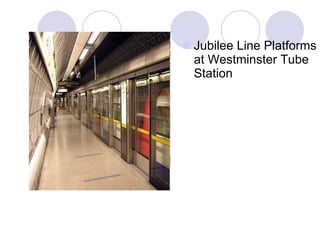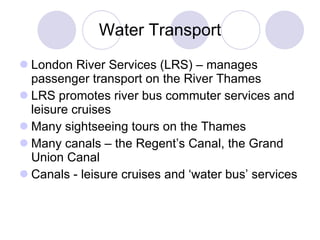Public transport in london
- 1. Public Transport in London Anna-Liisa Purtsak C. R. Jakobson Gymnasium 11c Supervisors: Marje Maasen, Tiia Pukk 2011
- 2. General I nformation Road, rail , water and air network in London Administered by Transport for London (TfL) T f L: London Buses and Tramlink , London Overground and Underground rail services Tickets: Travelcard, Oyster card
- 3. London Underground – The Tube The oldest metro system in the world – 1863 3 million passengers every day 2 70 stations, 402 kilometers 11 lines – connect the suburbs to Central London and provide distribution role around the city centre
- 4. Tube Map
- 5. Jubilee L ine P latforms at Westminster T ube S tation
- 6. Tramlink The world’s oldest tram system, dating back to the Victorian time Modern tramway was opened in 2000 Serves mainly South London A mixture of street track shared with other traffic A rticulated low floor trams , 39 stations Also known as Croydon Tramlink
- 7. A Tramlink Tram at Beckenham Junction T erminus
- 8. B us es in London One of the most extensive bus systems in the world, the largest in Europe Have been in use since 1829 Over 6,800 scheduled services every day, 6 million passengers, 700 routes 100-route night bus services for 24 hours Local buses – bendy buses (single deck and three sets of doors)
- 9. Double- D ec k er B uses The red double-dec k er buses – national symbol of Britain Ha ve two ‘decks’ M odern low-floor accessible vehicles ‘ The way to see London is from the top of a ‘bus’ – William Ewart Gladstone The Routemaster - traditional bus with open-platform , only heritage routes
- 10. A Double-Decker in London
- 11. Air N etwork, A irports London – best served city by airports in the world 150 million passengers annually Airports: Heathrow, Gatwick, Stansted, Luton, London City, Biggin Hill They serve long- haul , European and domestic flights Connected to central London by rail services
- 12. Taxis A Hackney carriage or black ca b - ‘The Knowledge’, can be hailed from streets or be booked Private Hire Vehicles or minicabs - ‘The Knowledge’, must be booked in, very often touted Bicycle taxis and pedicabs – no test of knowledge is required, not licensed
- 13. A Hackney Carriage or Black Cab
- 14. Water Transport London River Services (LRS) – manages passenger transport on the River Thames LRS promotes river bus commuter services and leisure cruises Many sightseeing tours on the Thames Many canals – the Regent’s Canal, the Grand Union Canal Canals - leisure cruises and ‘water bus’ services
- 15. A River Bus on the River Thames
- 16. A Water Bus in Regent’s Canal
- 17. Cycling Cheaper and often much quicker than other public transport Only 2 per cent of journeys made by bike Over 1 million Londoner s own bicycles 480,00 cycle journeys every day The Barclays Cycle Hire – bicycles sharing scheme, provides 6,000 bicycles for rental Bicycles for rent all over the city
- 18. Barclays Cycle Hire Docking Station in Soho Square
- 19. Thank you for your attention!
- 20. References http://shrt.st/12rl http://shrt.st/12rm http://shrt.st/12rn http://shrt.st/12ro http://shrt.st/12rp http://shrt.st/12rq http://shrt.st/12rr http://shrt.st/12rs http://shrt.st/12rt http://shrt.st/12ru
Editor's Notes
- Like we know all big cities have problems with traffic and that is why they have a great public transport system. In London, public transport includes road, rail, water and air network. Traffic is administered by Transport for London which is a government’s body and is responsible for managing transport services in London. Transport for London is responsible for London Underground and Overground rail services and London Bus and Tramlink system. For paying, people use Travelcards. They are in use for a day and cost about £5-£10. There are also special cards which are called Oyster cards. They are blue credit-card-sized electronic smart cards which can hold a variety of single tickets, period tickets and travel permits. They are recharged and can be used for many years. For example annual oyster card for students costs £356 and for adults £712.
- The fastest way of travelling in a big city is definitely by rail. Subway and the tube are very popular for covering long distances. London has the oldest metro system in the world. About 3 million passengers use it every day. There are 320 underground stations and the whole rail system compares about 402 kilometers. There are 11 different lines which connect suburbs to central London and provide distribution role around the city center.
- Tramlnik is one of the main Underground services in London. It’s the world’s oldest tram system dating back to Victorian time. The modern tram system was opened in 2000 and it serves mainly southern part of London. Tram system is a mixture of street track shared with other traffic. There are 39 stations all over London and trams are very comfortable because of their articulated low floors. London Tramlink is also known as Croydon Tramlink because it serves the large employment sector of Croydon on the southern edge of London.
- London bus system is also on of the oldest and it was firstly used already in 1829. It is one of the most extensive bus systems in the world and definitely the largest in Europe. There are over 6,800 scheduled services every day with about 6 million passengers. And there are 700 different routes all over the city. London bus system is special because it is opened 24 hour. During the night time there are about 100-route night buses. Local buses are called Bendy buses are special because they have single deck and three sets of doors. All the other buses, like Double-decers have two sets of doors.
- Many people know that London is full of red busses. These buses are called DOUBLE-DECERS and they are known all over the world because they are the national symbol of Britain. Double-decers have two decks and they are flow-floor accessible vehicles. Some double-decers are used in sight-seeing tours and are very popular among tourists. Like William Ewart Gladstone said: „The way to see London is from the top of a ’bus’“. There is another type of buses which are called Routemasters and they are special because they have open-platform. Routemasters were introduced in 1956 and were used until 2005. But right know there they are only for heritage routes.
- London is one of the best served city by airports in the world. About 150 million people travel every year through London airports. The biggest are Heathrow, Gatwick, Stansted, Luton, London City and Biggin Hill. They serve long-haul flights to all over the world, European flights and also flight within the UK. Bigger airports are connected to central London by rail services. For example Heathrow has special railways in London Underground, like Heathrow Connect and Heathrow Express.
- There are two types of taxis in London – Hackney carriage or black cab and Private Hire Vehicles or minicabs. Both these taxis are driven by the only taxicab drivers in the world who have spent at least three years learning the city inside out to gain ‘The Knowledge’. Black cabs can be hailed on the street or they can be booked as needed. But minicabs cannot be hailed on the street and they must always be booked in advance by phone or operators office. They can often be touted, so when someone offers you a minicab on the street then you know that it is not insured to carry passengers. And then there are bicycle taxis and pedica bs which are totally normal cab like we have in here. Only drivers don’t need the knowledge test and they are not licensed which means they can decide how much money are going to ask.
- The River Thames is a major river flowing through southern England and therefore through London too. Organization which manages passenger transport on the river is London River Services. It’s belongs to Transport for London and promotes river bus commuter services and leisure cruises. During the summer there are many sightseeing tours in tourist boats, past the more famous riverside attractions such as the Houses of Parliament and the Tower of London. There are also many canals in London, for example the Regent’s Canal and the Grand Union Canal. Canals also offer leisure cruises and there are ‘water buses’ which serve local people.
- Lately, more and more people use bicycles instead of using other public transport. They say cycling is much quicker and cheaper. But still, only 2 per cent of journeys in London are made by bikes. Today, over 1 million people in London own bicycles but only about half of them use their bikes daily. The main organization which shares bicycles all over London is The Barclays Cycle Hire. It provides about 6,000 cycles for rental.



















